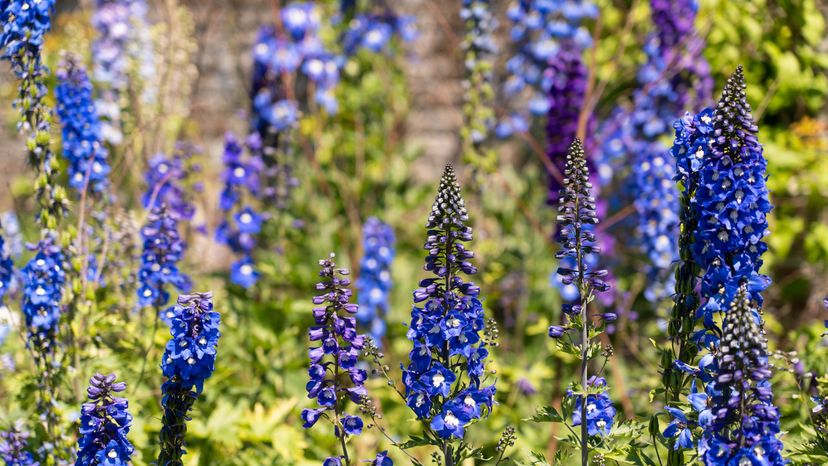
Delphinium, or larkspur, derives its genus' name from the Greek word for "dolphin" and is suggested by the shape of a gland in the blossoms that secretes nectar. Many delphiniums are poisonous to cattle.Description of delphinium, larkspur: The alternate leaves are cut and divided. Plants produce tall spikes of showy flowers, usually in shades of blue, each having a long spur behind the petals. Ease of care: Moderately difficult.
: Delphiniums are worth almost any effort to grow because they are so beautiful. They need full sun and a good, deep, well-drained, evenly moist soil that has a high humus content. If the soil is too acid, agricultural lime should be added. They are hardy feeders that must be supplied with compost or well-rotted manure, benefiting from feedings of a 5-10-5 fertilizer every year.
Advertisement
The area where they grow should have some protection from high winds because the hollow flower stalks, though strong, are often so covered with flowers that they can easily break in the breeze. Many gardens use delphiniums in front of stone walls for this reason. Without such protection, the gardener will have to resort to staking.
After flowering, flower heads should be removed unless seeds are wanted. Surprisingly, these plants are very cold-hardy and resent hot climates and long, blistering summers, Delphiniums are short-lived perennials that lose their vitality after two to three years. Since they grow easily from seeds and cuttings, propagation is never a problem.
Propagating delphinium, larkspur: By cuttings, by seed, or by careful division.
: Short delphiniums can be used in the front of a garden, the Belladonna hybrids in the middle, and the tall Pacific Coast hybrids in the rear. They are excellent cut flowers, too.
Delphinium, larkspur related species: Only hardy to USDA 8, Delphinium cardinale, or scarlet larkspurs, are lovely flowers for the summer garden. Delphinium elatum, or the candle larkspur, is one of the sources for many of the most beautiful delphinium hybrids today. Reaching to 6 feet, the flowers are now available in white, lavender, blue, and purple.
The Belladonna hybrids are light blue with 5-foot stalks and, if spent flowers are removed, they will usually produce blooms all summer long. Casa Blanca is pure white. The Blackmore and Langdon hybrids were first developed in 1905. Today's plants bear pastel blue, lavender, white, violet, and indigo flowers on 4- to 5-foot stems. The Pacific Coast hybrids produce 7-foot stalks that must be staked even when given protection; the flowers in various shades of blue and pink are spectacular. Magic Fountain is a dwarf version growing to 30 inches with double blooms.
Connecticut Yankee is a bush delphinium with single flowers of mixed colors on 30-inch stalks. Delphinium grandiflorum (sometimes called D. chinensis), or the Siberian larkspur, has finely cut foliage and blue flowers on 2- to 3-foot stalks, blooming the first year from seed if started early. Blue Mirror has gentian-blue flowers, and Alba is white.
Scientific name of delphinium, larkspur: Delphinium species
Advertisement